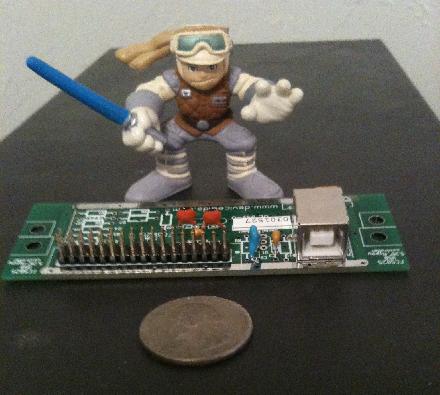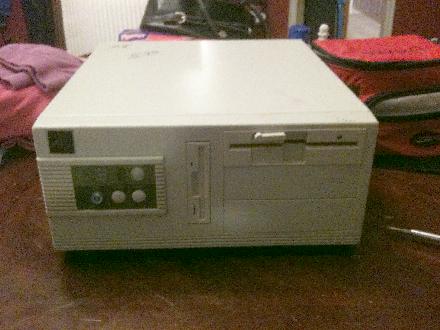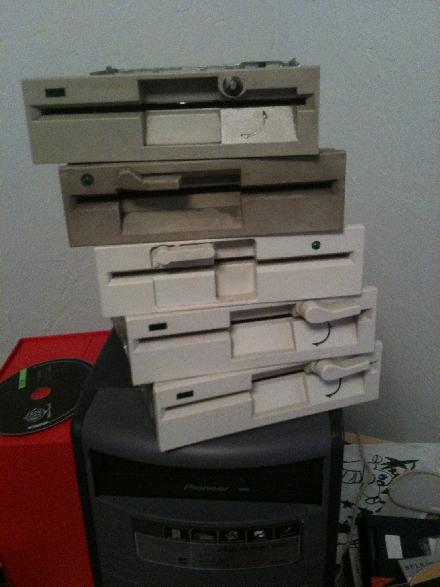I am, as the kids like to say, “old school”. I like old technology, I like old video games, I like old arcade games, and I particularly like old computers. When I say “old computers”, I am mostly referring to 8-bit machines from the 1980s: the Commodore 64, the Apple II, the TRS-80, and so on.
In the spirit of Jeopardy, if the preceding paragraph was the answer, the question would be, “What kind of person would be interested in purchasing (or would even have a use for) an FC5025?”
The FC5025 is a custom USB drive controller for 5 1/4″ floppy drives. That, in a nutshell, should tell you right away if the FC5025 is something you need in your life. Some of you are excited. Some of you are scratching your heads. The rest of you probably just quit reading, which is my sign to crank the “geek dial” up to 11. Brace yourselves.
For my generation, the 5 1/4″ floppy represented computers. Back before we had 3 1/2″ disks — hell, back before we had hard drives — we just had floppies. Our family didn’t own a hard drive for our PC until the late 1980s. For almost a decade, my house was Floppy City.
As I’ve stated multiple times on my blog, I still own a lot of floppy disks from that era. And even though I still own a lot of those diskettes, what has disappeared are the disk drives needed to read them. It’s getting tougher these days to find a machine with an internal 3 1/2″ floppy drive, much less a 5 1/4″. Multiple manufactures have created external USB 3 1/2″ drive solutions, but unfortunately none of those are compatible with 5 1/4″ drives.
That’s where the FC5025 comes in. The board itself is tiny, and despite the fact that it’s USB, it’s designed to be mounted inside your PC. Why they built it that way, I’m not sure. Everybody I know who owns one of these boards (okay, all 3 of us) immediately mounted them in external drive caddies. Installed as intended, a person would mount a 5 1/4″ drive internally inside their PC, connect a power cable from their PC’s power supply to the back of the floppy drive, and connect the FC5025’s USB port to an internal USB port inside your computer (to power the card). An external solution requires mounting a 5 1/4″ floppy inside some sort of external drive caddy for power and running a USB cable from the caddy to an external USB port on your computer. The latter solution makes much more sense to me, personally.
To break up all this text, here is a picture of the card itself. I put Luke in the picture for scale but then I decided people might not know how tall Luke is so I put a quarter in there too.

The FC5025 costs $55.25, which does not include a floppy drive. I thought for sure I had saved one or two old 5 1/4″ floppy drives out in the garage, but I had not. An acquaintance of mine (“Aardvark”) kindly mailed me an old floppy drive — and when I couldn’t get that one to work, he mailed me another one. Not only does the guy have access to 5 1/4″ drives — he has 5 1/4″ drives to spare. Aardvark is cooler than you. In between those two arriving, I began searching thrift stores for a working drive. I bought this beast for $5, and although the computer itself worked, the drive was still giving me fits.

The software that comes with the FC5025 claims to be able to back up Apple, Atari, Commodore, MS-DOS, North Star, and TI-99/4A diskettes. This is the unit’s main (really only) selling point. The only reason someone would want to own an FC5025 is if they intended on backing up/archiving old floppy disks (the unit is read only and does not support writing disks of any kind). And yet, despite my efforts and no matter how many different floppy drives I tried, I could not get the unit to read the back side of any of my old floppy disks.
To give you an idea of how many different floppy drives I tried, the top of my computer looks like this right now:

Yeah. So after a bit of investigating (ie: reading the directions), I learned that the FC5025 is basically currently incapable of reading the back side of old diskettes. Old disks that you “flipped” over are referred to as “flippy” disks, and due to a difference in manufacturing techniques, PC floppy drives cannot read the back side of old flippy disks. Apparently they can be modified to do so (see here and here), but it ain’t easy.
In my defense, this is what the website says:
“The FC5025 may be unable to read the second side of “flippy” disks, depending on the drive it is attached to.”
(I saw the word “may”. I thought I had a chance.)
“Many drives won’t read from the disk unless they can see the index hole. If you have one of these drives, the FC5025 will be able to read from the first side of the disk only. When you flip the disk over to read the other side, the drive will not send any data to the FC5025, and the FC5025 will not be able to read that side.”
(Again, I saw “many drives won’t”. That made it sound like “some will”.)
“The FC5025 … has been tested to work well with the TEAC FD-55GFR drive and should also work with most other 5.25″ drives.”
I guess I read between the lines a bit too much. Based on the above information, I assumed that TEAC FD-55GFR drives would, in fact, read the second side of a “flippy disk”. I can tell you that, unmodified, they will not. The top two drives on my pile are TEAC FD-55GFR drives.
The reason I am putting so much emphasis on this one particular “flaw” is that, besides that, the FC5025 is incredible. With my computer case open and cables strung out across my desk, it took me about a minute to connect the card, a drive, and install the included drivers and software. The included transfer program gets right to the point. Pick a disk format, a location and a file name, and you’re on your way. The FC5025 is faster than you would imagine; disks transfer in well under 30 seconds. There are PC, Mac, and Linux versions of the software included.
Although every Commodore 64 diskette I transferred using the FC5025 reported multiple read errors, every one of them worked. Perhaps the read errors were on parts of the disk that didn’t contain data, I’m not sure. Bottom line though, in under 30 seconds I was able to transfer a 25-year-old Commodore floppy disk to a .D64 disk image, double-click the file, and play an old game in using WinVice on my modern PC. That’s pretty impressive. I had similar luck with the Apple II floppies I tried.
And yet, I can’t help but feel a little bummed. For how great this device performed, for most real world collectors, it’s essentially worthless. I don’t know a single old school computer guy who didn’t save files and programs onto the back of any diskette he could get his hands on. Yes, the FC5025 works great — for the half of my collection that sits on the front side of flippy disks. I suppose if one wanted to archive IBM PC diskettes, the FC5025 would work grand. For anyone wanting to archive old C64, Apple, or Atari diskette collections, unless you’re willing and able to heavily modify an old floppy drive, you’ll be disappointed.
The reason I named this article “Part I” is because I am hoping someday there will be a Part II. I will write Part II when I have either modified a floppy drive to read flippy disks, or some update to the software/firmware allows me to do it on a stock drive. Until then, the FC5025 (in its custom-but-unfinished Commodore 1541 case) will probably go up on a shelf, sitting alongside all the other gadgets I’ve bought that were “almost” perfect.




















